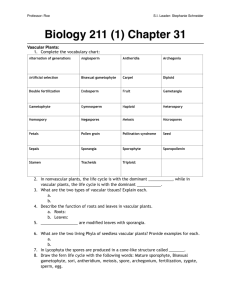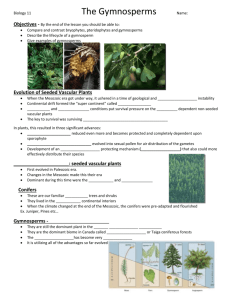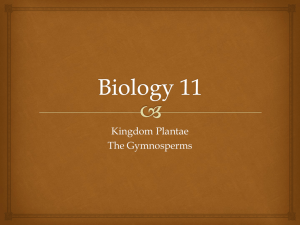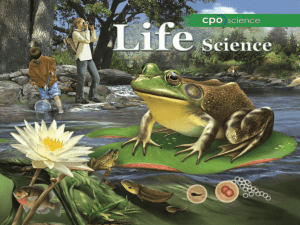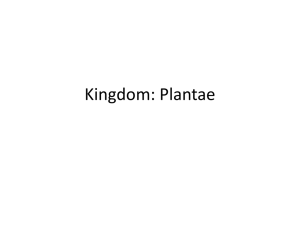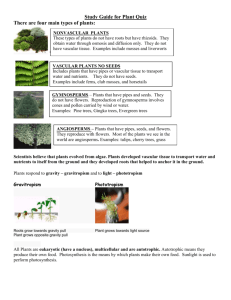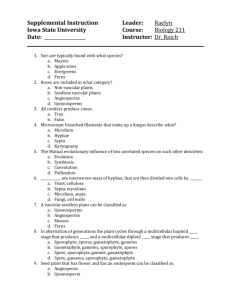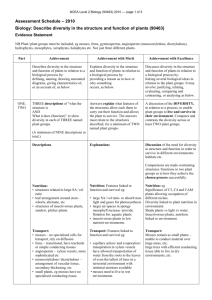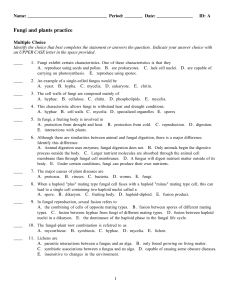CHAPTER OUTLINE
advertisement
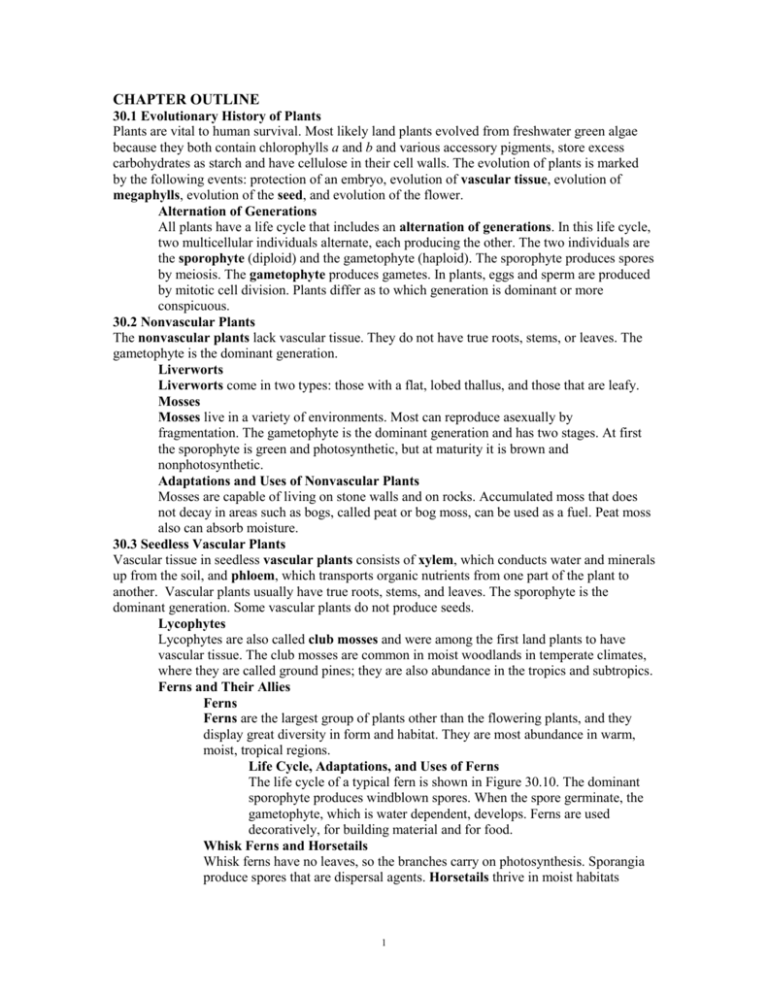
CHAPTER OUTLINE 30.1 Evolutionary History of Plants Plants are vital to human survival. Most likely land plants evolved from freshwater green algae because they both contain chlorophylls a and b and various accessory pigments, store excess carbohydrates as starch and have cellulose in their cell walls. The evolution of plants is marked by the following events: protection of an embryo, evolution of vascular tissue, evolution of megaphylls, evolution of the seed, and evolution of the flower. Alternation of Generations All plants have a life cycle that includes an alternation of generations. In this life cycle, two multicellular individuals alternate, each producing the other. The two individuals are the sporophyte (diploid) and the gametophyte (haploid). The sporophyte produces spores by meiosis. The gametophyte produces gametes. In plants, eggs and sperm are produced by mitotic cell division. Plants differ as to which generation is dominant or more conspicuous. 30.2 Nonvascular Plants The nonvascular plants lack vascular tissue. They do not have true roots, stems, or leaves. The gametophyte is the dominant generation. Liverworts Liverworts come in two types: those with a flat, lobed thallus, and those that are leafy. Mosses Mosses live in a variety of environments. Most can reproduce asexually by fragmentation. The gametophyte is the dominant generation and has two stages. At first the sporophyte is green and photosynthetic, but at maturity it is brown and nonphotosynthetic. Adaptations and Uses of Nonvascular Plants Mosses are capable of living on stone walls and on rocks. Accumulated moss that does not decay in areas such as bogs, called peat or bog moss, can be used as a fuel. Peat moss also can absorb moisture. 30.3 Seedless Vascular Plants Vascular tissue in seedless vascular plants consists of xylem, which conducts water and minerals up from the soil, and phloem, which transports organic nutrients from one part of the plant to another. Vascular plants usually have true roots, stems, and leaves. The sporophyte is the dominant generation. Some vascular plants do not produce seeds. Lycophytes Lycophytes are also called club mosses and were among the first land plants to have vascular tissue. The club mosses are common in moist woodlands in temperate climates, where they are called ground pines; they are also abundance in the tropics and subtropics. Ferns and Their Allies Ferns Ferns are the largest group of plants other than the flowering plants, and they display great diversity in form and habitat. They are most abundance in warm, moist, tropical regions. Life Cycle, Adaptations, and Uses of Ferns The life cycle of a typical fern is shown in Figure 30.10. The dominant sporophyte produces windblown spores. When the spore germinate, the gametophyte, which is water dependent, develops. Ferns are used decoratively, for building material and for food. Whisk Ferns and Horsetails Whisk ferns have no leaves, so the branches carry on photosynthesis. Sporangia produce spores that are dispersal agents. Horsetails thrive in moist habitats 1 around the globe. The small, scalelike leaves are nonphotosynthetic. The stems of horsetails are tough and rigid because of silica deposited in their cell walls. 30.4 Seed Plants Gymnosperms and angiosperms are categorized as seed plants. Seeds contain a sporophyte embryo and stored food within a protective seed coat. The survival value of seeds largely accounts for the dominance of seed plants today. Seed plants are heterosporous, they have two types of spores, and they produce a male and female gametophytes. Gymnosperms Most gymnosperms are cone-bearing plants. On the surface of their cone scales are ovules that are not completely enclosed by diploid tissue, which later become seeds. Gymnosperms are divided into four groups: conifers, cycads, ginkgoes, and gnetophytes. Conifers The better-known gymnosperms are evergreen, cone-bearing trees called conifers. Adaptations and Uses of Conifers Conifers are adapted to cold, dry weather. The dominant sporophyte produces two kinds of cones: pollen cones produce windblown pollen cones and seed cones produce windblown seeds. Conifers supply much of the wood used to construct buildings and to manufacture paper. Other Gymnosperms Cycads have large, finely divided leaves growing in clusters at the top of the stem. Ginkgos are represented today by only one surviving species, the maidenhair tree. The three living genera of gnetophytes don’t resemble one another. Angiosperms Angiosperms, the flowering plants, are an exceptionally large and successful group of plants. The seed develops from an ovule within an ovary, which becomes a fruit. Therefore, angiosperms produce covered seeds (in contrast to the exposed seeds of gymnosperms). Monocots and Eudicots Most flowering plants belong to one of two classes: monocots or eudicots. Monocots have only one cotyledon in their seeds, whereas eudicots have two cotyledons. The Flower The flower stalk expands slightly at the tip into a receptacle, which bears the other flower parts. The sepals protect the flower bud before it opens. The petals are quite diverse and often attract pollinators. The stamen consists of an anther, where pollen is produced, and a filament. The carpel consists of the ovary, which contains ovules, the style, which elevates the stigma, which receives pollen grains. Life Cycle, Adaptations, and Uses of Flowering Plants Sexual reproduction in flowering plants is dependent on the flower, which produces both pollen and seeds. Some species have windblown pollen, and others rely on a pollinator such as bees, wasps, flies, butterflies, moths, beetles, and even bats. Fruits aid in the dispersal of seeds. 2


